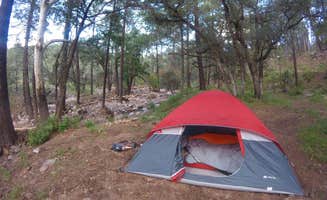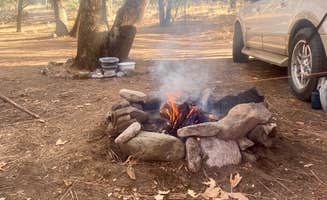Tent camping near Playas, New Mexico primarily requires venturing into Arizona's Coronado National Forest, with most sites located 30-60 miles from Playas. The region sits at elevations between 5,000-6,000 feet, creating moderate summer temperatures and cold winter nights. Monsoon season (July-September) brings afternoon thunderstorms that can temporarily raise water levels in creeks and make dirt access roads challenging.
What to do
Creek exploration: Sycamore Campground offers excellent opportunities to explore mountain streams. "The campground is situated right next to a mountain stream that is cool to explore. It's a little tough to get to but it's worth it," notes Cody B. Multiple small pools form along creek beds during spring and early summer.
Waterfall hikes: West Turkey Creek Dispersed provides access to seasonal water features. "Turkey creek flows right next to the campground and offers fantastic hikes along its banks. There are multiple small waterfalls and pools to splash in," according to Travis D. The trails follow creek beds with minimal elevation gain, suitable for most fitness levels.
Wildlife viewing: Rucker Lake - Tahoe National Forest offers opportunities to spot regional wildlife. "Various campsites on Rucker lake. Close waterfalls and plenty of hiking trails," reports Tanner H. Early morning and dusk provide optimal viewing times for deer and wild turkeys.
What campers like
Privacy and isolation: Most dispersed sites offer significant distance between campers. "We stayed in a dispersed spot about a mile before Sycamore Campground - it was great! Very private and next to a babbling creek," shares Caitlyn B. Sites along forest service roads typically provide 50-100 feet between campsites.
Night sky viewing: Herb Martyr Campground provides exceptional stargazing opportunities due to minimal light pollution. "The night sky is unparalleled," notes Holly W. The Cave Creek area offers some of the darkest skies in the Southwest.
Uncrowded camping: Camp Rucker - Coronado National Forest and similar sites rarely reach capacity except during holiday weekends. "This little out of the way spot has never been busy during our multiple visits. Plan to stay more than one night because you'll be sad to leave," writes one visitor about nearby West Turkey Creek.
What you should know
Road conditions: Access to most camping areas requires navigating unmaintained roads. "The only con is that it is a bit out of the way, with 8-10 miles of unmaintained dirt road to get there. In my experience, the road was pretty washboard the whole way," warns Jonathan E. High-clearance vehicles are recommended, especially after rain.
Supply planning: No grocery stores exist within 30 miles of most camping areas. "No water, so bring your own," advises Holly W. about Herb Martyr Campground. Campers should pack enough water for drinking, cooking, and basic hygiene, calculating 1-2 gallons per person per day.
Limited capacity: Most established campgrounds have few designated sites. "We counted only three official sites, though none were numbered. Those sites include a picnic table and a fire ring. One was huge, one medium and one small," reports a camper at Herb Martyr. Arriving mid-week or early in the day improves chances of securing a site.
Tips for camping with families
Bear safety: Store food properly using provided bear boxes where available. "Nice, small campground with pit toilets, fire rings and bear boxes. Saw many deer and turkeys in the area," notes Cole M. about Sycamore Campground. Teach children proper food storage protocols and never leave food unattended.
Creek activities: Shallow creek areas provide natural play spaces during warmer months. "There are multiple small waterfalls and pools to splash in," mentions a visitor about Turkey Creek. Water levels vary seasonally, with spring typically offering the most reliable flow.
Wildlife education: Rucker Forest Camp and surrounding areas offer chances to teach children about desert ecology. "The creek was flowing and quite a few animals at dawn and dusk," reports Tracy T. about a nearby site. Bring binoculars and wildlife identification guides suitable for children.
Tips from RVers
Site selection: Choose established campgrounds for larger vehicles. "It is at the end of a dirt road... The first 20 yards after the turn are pretty rough and rocky and more of an issue driving up them than down them," notes Holly W. about access to Herb Martyr Campground. Most dispersed sites cannot accommodate vehicles longer than 25 feet.
Turnaround space: Limited turnaround areas exist on forest roads. "To get to the sites, you make a hairpin turn (there is ample room to swing wide in a car with no trailer)," advises a camper. Scout ahead without your trailer if unsure about access.
Dumping facilities: The region has minimal services for RVs. Some campgrounds like Sycamore list sanitary dump facilities, but these may be seasonal or limited. Fill water tanks and empty holding tanks before arriving, as the nearest full-service facilities are in larger towns 50+ miles away.



